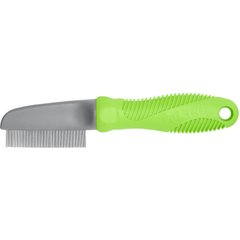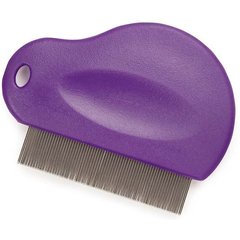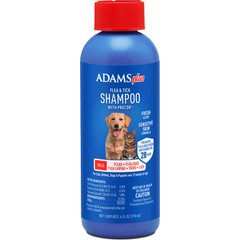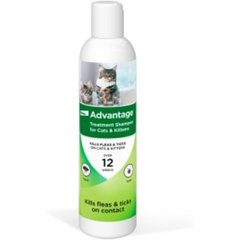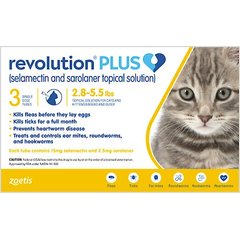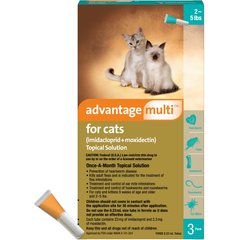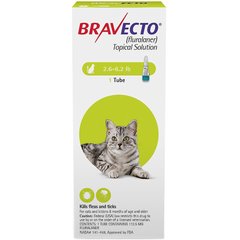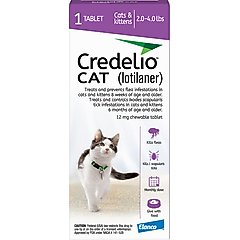How To Get Rid of Cat Fleas
Cat fleas can be frustrating, stressful, and gross—plus, they’re harmful to a cat’s health and comfort. Luckily, they’re steps you can take to tackle flea problems once and for all.
We spoke to vets for their tips on sending fleas packing. From understanding signs of fleas to preventing future infestations, we’ve got the lowdown on treating fleas on cats.
What Are Cat Fleas?
Fleas are small parasitic insects—only about 3mm long—which makes them smaller than a grain of rice.
They have six legs, no wings, and are brown, with a body that is taller than it is wide.
Fleas can move very quickly and jump incredible distances given their size. If you happen to find one on your cat, it may seem to be there one second and gone the next.
It’s often easier to find flea feces (flea dirt) than it is to find the fleas themselves. Flea dirt looks like coffee grounds and tends to be located at the base of the tail, along the back of the hind legs, and around the face, armpits, and groin.
However, cats are such good self-groomers that they can remove most of the evidence of a flea infestation. If your cat is itchy, fleas may be to blame even if you don’t see them.
Cat Flea Life Cycle
There’s reason to understand the stages of fleas’ lives. Why, may you ask?
Most flea treatments don’t kill fleas in all of stages of life. Because of this, it’s important to check products to make sure you’re targeting each stage.
Adult fleas only account for about 5% of an existing flea population. 95% of the fleas in your home are in earlier stages of the life cycle.
Here’s how a flea’s life cycle works:
- Stage 1 (Egg): Eggs are laid by female fleas and can lay dormant for days to weeks. They may be laid in your cat’s fur, in the carpet or anywhere else in the house that provides safe refuge. Flea eggs can also transfer from your cat to other pets or parts of the home.
- Stage 2 (Larvae): Eggs eventually hatch into flea larvae, which are tiny, transparent, and legless creatures. They feed on blood found in flea dirt (aka flea feces), flea eggshells, and other organic matter. Larvae remain in this stage anywhere from one to three weeks before spinning a cocoon around themselves.
- Stage 3 (Pupae): Once wrapped into a cocoon, flea larvae become pupae. This life stage is the most resistant to flea control treatments, and what’s worse, pupae can remain dormant for weeks, months, and in extreme cases even years before hatching into an adult flea. Typically, they’ll hatch once conditions are warm and humid.
- Stage 4 (Adult flea): Fleas in the adult stage are the most obvious—these are the tiny brown insects you might have spotted. This stage can lead to a major boost in future fleas since adult female fleas lay as many as 50 eggs per day.
The entire life cycle takes about three weeks on average—but for some fleas, it can take months or even years. That’s why it’s important to keep your guard up year-round by using flea and tick preventative treatments on your cat.
How To Tell If a Cat Has Fleas
All cats, even indoor-only cats, can get fleas.
Common signs your cat has fleas include:
- Frequent itching and scratching, especially on their back legs (where fleas love to hide).
- Biting at their skin or fur.
- Overgrooming or excessive licking of the skin or fur.
- Hair loss, which is often more prevalent on a cat’s back half where fleas tend to congregate.
- Skin irritation, redness, open wounds, or scabbing.
- Flea dirt on your cat’s skin. (You can tell the difference between flea dirt and actual dirt by placing the specks on a damp paper towel. If they turn reddish-brown, it’s flea dirt.)
- Live adult fleas running and/or jumping through your cat’s fur. These are often easier to spot by combing through your cat’s hair with a flea comb. Find out more about what fleas look like.
- Agitation, restlessness, or general discomfort.
How To Get Rid of Fleas on Cats
There are simple steps you can take to get rid of fleas on your cat and in your home. Once you’ve solved your flea problem, you can continue with flea prevention measures to ward off future infestations.
If you have multiple animals in your home, you need to address fleas on all of them.
Otherwise, the fleas will just keep moving from one pet to another, and you’ll struggle to get rid of them.
Follow these steps with each of your pets to ensure those fleas have nowhere to hide.
1. Use a Flea Comb
Remove as many fleas as possible from your cat using a flea comb.
Slide the comb into their fur gently against their skin, then pull upward to pull off live fleas. You can place the collected fleas in a bowl of isopropyl alcohol to kill them.
Take your time and be thorough—fleas really like to hide in hard-to-reach areas and thick fur.
Recommended flea combs include:
Recommended Products
2. Give Your Cat a Flea Bath
After using a flea comb, give your cat a flea bath.
Like most cat parents, you’ve probably never attempted bathing your cat before. It can be a tricky task, given some cats’ aversion to water, but flea shampoos can kill adult fleas and rinse away flea dirt.
Read the label on the flea shampoo closely as some products are meant for dogs only and are very dangerous for cats. Most flea shampoos aren’t appropriate for young kittens.
The following shampoos can be used on cats who are over 12 weeks of age:
Recommended Products
3. Use a Cat Flea Prevention Treatment
If you’ve fallen behind on your cat’s regular flea and tick prevention treatment, there’s no time like the present to get back on track. These treatments can kill remaining fleas on your cat and prevent future infestations, too.
You have several options when it comes to flea prevention, including:
- Topical flea and tick treatments: These flea control serums are applied directly to your cat’s skin. If you’re using a topical treatment, wait to apply it until after bathing your cat, not before, to avoid accidentally washing away the treatment.
Recommended Products
- Oral flea and tick treatments: These preventatives come in pill or chewable form.
Recommended Product
Consult with your veterinarian to determine which method is right for your cat.
Whatever flea prevention you choose, stay consistent.
Give the medicine to your cat year-round, according to product instructions and your veterinarian’s recommendations.
Missing treatments could allow future infestations.
4. Treat Your Home for Fleas
Along with treating your cat—and all other pets in your home—it’s important to take some time to tend to your environment. Take these steps to eliminate fleas in your home:
- Wash all the bedding in your home, along with cat beds, blankets, and toys, using hot, soapy water.
- Vacuum all carpeting and upholstery. Immediately empty the vacuum bag or container into the trash and throw the bag away outside. If your vacuum uses a canister, empty it immediately and clean the canister very well according to the vacuum manufacturer’s instructions. Flea eggs can live in the vacuum and hatch and come back out to reinfect the house, so a thorough cleaning is important.
In more extreme cases, you may need to use an insecticide. If that’s the case, follow label instructions carefully and make sure your pets are out of the home for the recommended period.
You can also hire a professional pest control company to help remove fleas from your home if the flea problem gets out of control.
Not all flea treatments for cats are safe for other pet species. If you live with more than one type of pet, always consult your veterinarian before using a flea-killing product on your home or yard.
If your cat is allowed outside, there’s a chance your yard may be infested with fleas, too. If you need to treat your yard with insecticide, follow the same rules as with home treatments:
- Remove your pets from your yard before treating it.
- Keep your pets out of the area for the product instructions’ recommended amount of time. (Usually, this is until the spray has dried.)
- Once your cat and any other pets are allowed outside, make sure they don’t eat any of the sprayed grass or plants.
A professional pest-control company can be helpful here, too. Make sure they’re aware that you have a cat and to follow their safety recommendations to protect both the humans and pets in your household from the chemicals they use.
Dangers of Cat Fleas
Fleas can make you and your cat uncomfortable—but that’s just the beginning of the long list of reasons to get rid of them.
Fleas can also transmit diseases, including:
- Tapeworms
- Plague
- Typhus
- Mycoplasma (hemobartonellosis)
- Cat scratch disease
An infestation can also cause an intense allergic reaction called flea allergy dermatitis in your pet, which typically comes with severe scratching that leads to skin infections and hair loss.
Some cats can have an extreme reaction to just a single flea bite.
Severe infestations may even lead to anemia, a condition in which your cat lacks enough healthy red blood cells. That’s why it’s important to treat flea infestations as soon as you notice the issue.
How to Get Rid of Cat Fleas FAQS
Q: What does a cat flea look like?
A: Cat fleas are small (less than 3mm long) and brown. It’s often easier to find flea dirt than the fleas themselves. Flea dirt looks a little like coffee grounds.
Q: Are cat fleas hard to get rid of?
A: Thankfully, there are many safe and effective products available to get rid of fleas on cats, including Revolution, Advantage II, and Capstar. Your veterinarian can recommend the best option for your cat.
Q: What kills fleas on cats instantly?
A: A bath using a flea shampoo is a good way to kill adult fleas and get them off your cat quickly. However, most flea shampoos don’t do much to prevent new flea infestations, which is why using a flea preventive is so important.
Always read the label closely because some flea shampoos are only meant for dogs and can be very dangerous for cats.
Q: Can humans get fleas from cats?
A: Fleas from cats can bite people. They often cause small, itchy red bumps on the lower legs.
Attributions
This content was medically reviewed by a veterinarian.
